Permian Basin Overview
The Permian Basin is located in west Texas and southeastern New Mexico, and has been producing oil commercially since 1921. To date it has produced over 29 billion barrels of oil and 75 trillion cubic feet of gas,
and it is estimated by the industry to contain recoverable oil and natural gas
resources exceeding that which has been produced since that first well.
Permian Basin Index Map
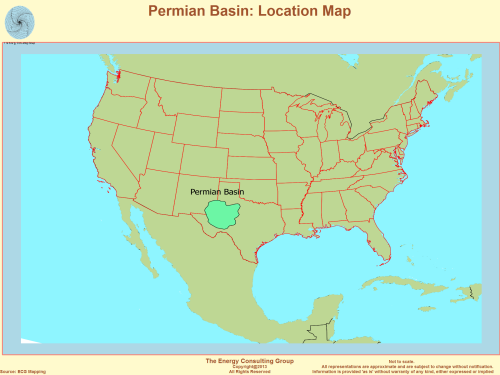
Click For Larger Image |
Permian Basin: SubBasins and Geological Features
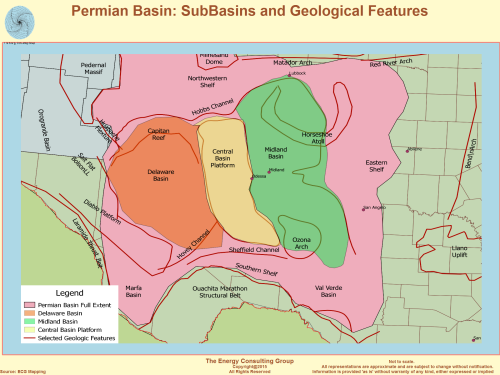
Click For Larger Image |
Permian Basin: Deep Structure Map

Click For Larger Image |
The map to the left provides a sense of the subsurface relief that
underlies many of the names the industry uses for different parts of
the Permian Basin. This particular map is a deep structure map,
but as is evident in the maps of the nonconventionals Wolfcamp below,
much of this relief is conserved at shallower depths. |
The oil and gas is contained in hundreds of distinct plays and produced from
over 7000 oil and gas fields and (some of which are shown on the map
titled, "Permian Basin Oil and Gas Plays"). For reference, we also include
a regional stratigraphic chart.
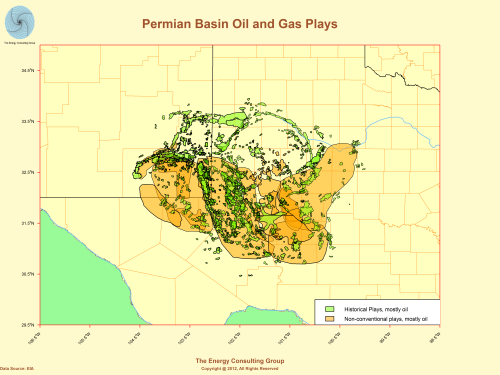
Click For Larger Image |

Click For Larger Image |
| |
|
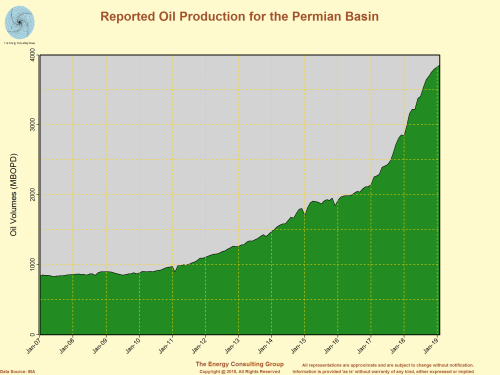
Click For Larger Image |
However, despite
the impressive volumes of oil remaining to be recovered from these fields, in the last decades of the 20th century Permian oil production was
flat to declining.
But, operators have successfully developed, tested and applied new technologies
to stem and reverse this trend, and are even now taking oil production to new
heights. |

Click For Larger Image |
The growth in natural gas output has been just as impressive. |
Permian Oil, Gas, and NGL Pipelines: Recent, In-Process, and
Potential
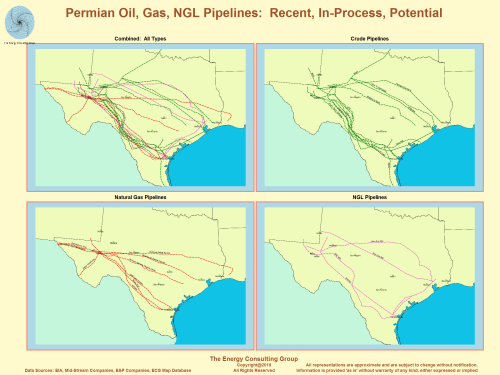
Click For Larger Image |
Permian Basin: Natural Gas Processing
Infrastructure
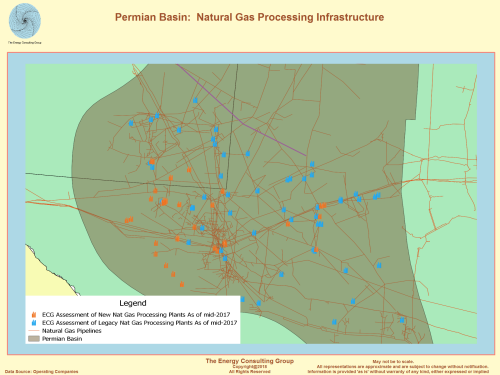
Click For Larger Image |
The rapid, voluminous growth of both oil and gas output has led to a
major infrastructure buildout to gather, process and transport the
commodities to markets. The markets are primarily on the Gulf
coast and increasingly beyond in Europe and Asia. To the left is a
map showing the various pipelines that have either been recently put in
service, are being constructed, or are being proposed.
The two sets of defining technologies most responsible for returning fortune to the Basin are horizontal drilling/multistage fracing and CO2 EOR. The application of these two technological advances has not only halted the long term decline in oil production, but led to the dramatic oil production increase
apparent in the previous chart.
Return to Web Page Index
Nonconventional Plays: Permian Basin

Of these two technological forces, horizontal drilling/multistage fracing (hdmsf) is the one most responsible for the reversal of fortune. Over the past
several years, several significant horizontal plays have emerged.
The figure to the right is a map, circa early 2017, of the Permian Basin with the estimated number
of rigs active at that time in each county listed in black. The large majority of
these rigs are drilling nonconventionals, tight oil wells, with the
more prominent of such plays outlined and labeled on the map. Of these plays,
the upper Wolfcamp in both the Midland and Delware subbasins is receiving the most attention. That said,
drilling for both the Spraberry and the Bone Springs is also quite active,
with local hotspots in both the Leonard and Avalon shales.
An attactive feature for the Permian shale oil industry is that in many areas,
the plays are stackable, meaning operators may be able to develop more that one
formation from a single well pad. The figure below left and titled, "Delaware
Basin: Potential Well Stack around State Line," is an illustrative 3D diagram
we developed to demonstrate the potential for stacking.
Delaware Basin: USGS Light, Tight Oil
Resource Potential
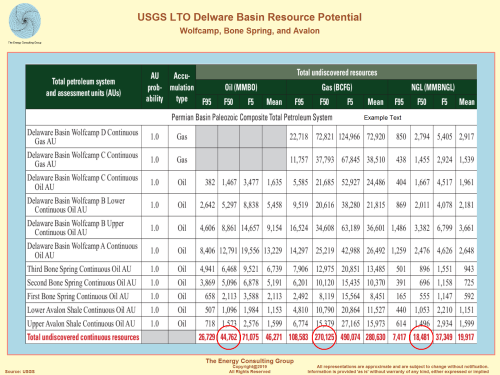
Click For Larger Image |
Midland Basin: USGS Light, Tight Oil
Resource Potential
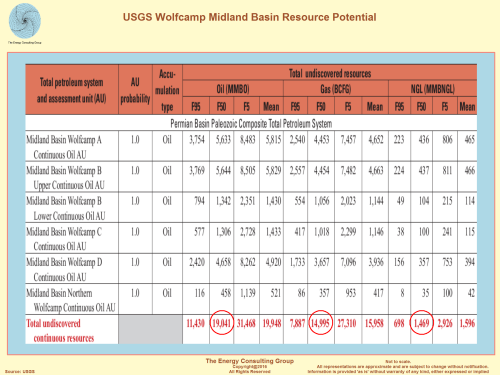
Click For Larger Image |
If the Permian Basin were a standalone county,
it's nonconventional oil resources would place it eighth in the world in
terms of its oil potntial.
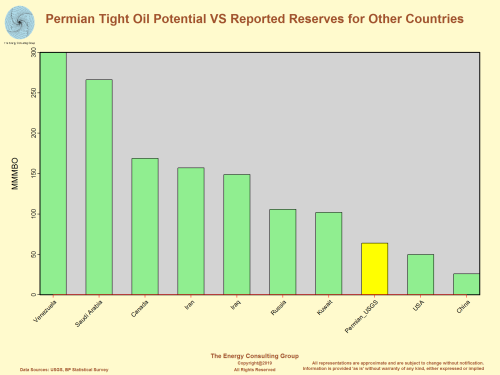
Click For Larger Image |
If the Permian Basin were a standalone county,
it's nonconventional gas resources would place it sixth in the world in
terms of its gas potential.
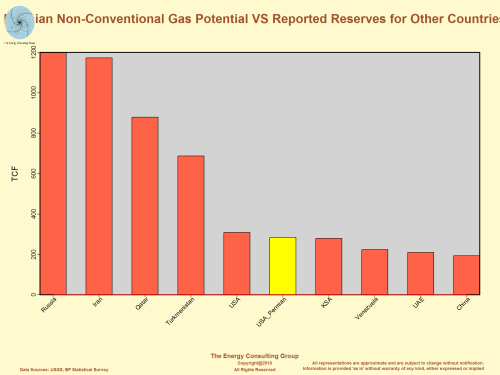
Click For Larger Image |
As mentioned previously, the Wolfcamp is currently the main nonconventionals
target in the Permian. To provide a sense as to the nature of the
formation, we developed a 3D map of the Wolfcamp structure, shown here.
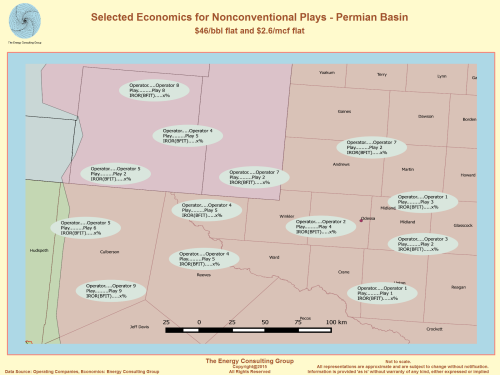 To
the left is an example of our economic comparison map. The well level
economics reflect well performance (IP's, decline curves and EUR) as
communicated by individual companies for different plays, which we analyzed
using EVAL, our proprietary economic analysis program. We have over 500 such
assessements for the Permian oil nonconventionals, starting in 2010, which provides detailed insights on not only the
economic performance of the nonconventional plays in the Permian Basin, but
also allow us to investigate questions regarding rig and well productivity
growth, impact of changes in technology, how much oil the basin is likely to
produce at different oil prices, and which firms are best positioned to exploint
the nonconventionals. And, yes, we do realize that many of the answers in
the map have been removed. If interested in the map with all the blanks
filled in please contact us at insight@energy-cg.com.
To
the left is an example of our economic comparison map. The well level
economics reflect well performance (IP's, decline curves and EUR) as
communicated by individual companies for different plays, which we analyzed
using EVAL, our proprietary economic analysis program. We have over 500 such
assessements for the Permian oil nonconventionals, starting in 2010, which provides detailed insights on not only the
economic performance of the nonconventional plays in the Permian Basin, but
also allow us to investigate questions regarding rig and well productivity
growth, impact of changes in technology, how much oil the basin is likely to
produce at different oil prices, and which firms are best positioned to exploint
the nonconventionals. And, yes, we do realize that many of the answers in
the map have been removed. If interested in the map with all the blanks
filled in please contact us at insight@energy-cg.com.
A quick note about the economic analysis program we have developed, which
in essense is our Aries equivalent. This program provides us the
opportunity to quickly assess with a high degree of granularity, the economics
at different scales of development including, individual wells, projects, regions, companies etc. and cross compare against
different development concepts, e.g. incremental economics of 1000 lbs/ft of sand
vs going with 2000 lbs/ft. Over the years we have
used this tool to track the evolution of different technologies, such as the
migration of the domestic natural gas industry away from tight gas developments
and towards shale gas, or more strategically, whether it makes more sense
(economically) to invest in the shales vs deep water or oil sands, to hi-light
just two alternatives. As a result, we have literally thousands of economic runs of
different situations be it in the Marcellus, Permian, Canada tight gas or oil
sands,
deepwater Angola, North Sea, China shale gas, etc.
The sophistication of the program comes from its ease of use, scalability and
risk handling. Its ease of use is grounded in it being spreadsheet based,
which is familiar and intuitive, meaning a new user can be up and running in
minutes. Its scalability is associated with it being able to quickly be
configured to evaluate the economics of any size project, be it a single well, a
pad, a year long campaign of hundreds of wells, or an integrated deep water
development. The risk handling feature applies the assessed risk at the
appropriate point in the project life cycle, e.g. exploration, delineation, development and
carries that risk through to the expected economics.
Return to Web Page Index
CO2 EOR: Permian Basin Overview
Selected USA CO2 EOR Regions
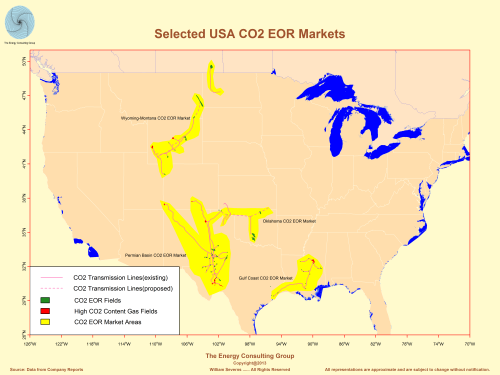
Click For Larger Image |
Permian
CO2 EOR Overview

>Click For Larger Image |
CO2 EOR Oil Production for the Permian Basin
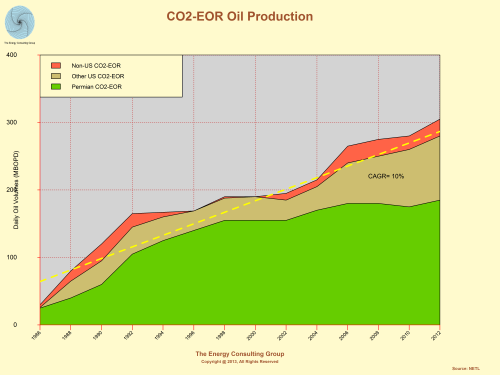
Click For Larger Image |
|
Return to Web Page Index
Permian Basin Drilling Activity Overview
Approx. Reported Permian Basin Horizontal Rig
Activity
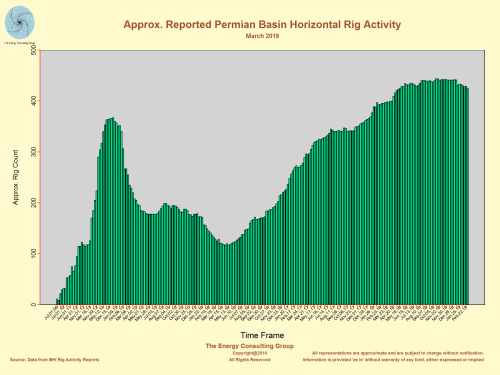
Click For Larger Image |
Approimate Horizontal Rig Count for Several Significant Tight Oil Play
Areas

Click For Larger Image |
Drilling Rig Activity In the Permian in March 2019
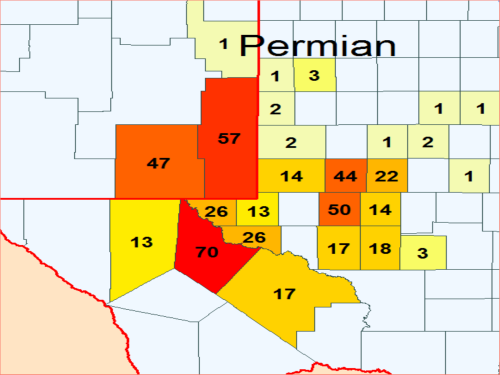
Click For Larger Image |
US Onshore Drilling Activity Heat Map (March 2019)

Click For Larger Image |

Click For Larger Image |
|
Return to Web Page Index
Acreage Positions As Reported By Operating Companies (The Energy Consulting Group makes
no representation as to accuracy)
Diamondback: Reported Permian Acreage Position as of
early-2019
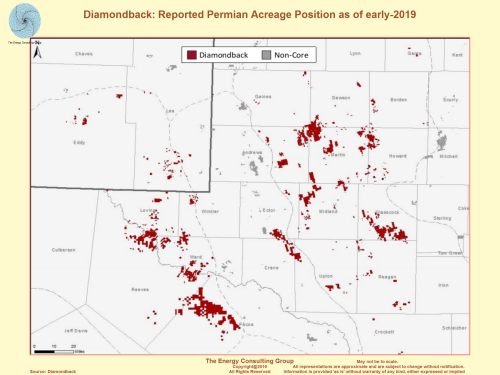
Click For Larger Image |
Occidental: Reported Permian Acreage Position as of early 2017
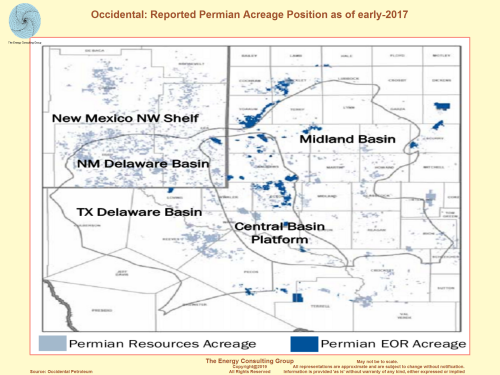
Click For Larger Image |
Apache: Reported Permian Acreage Position as of late 2016

Click For Larger Image |
Chevron: Reported Permian Acreage Position as of March 2019
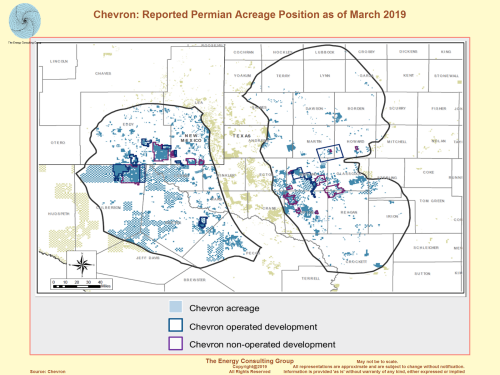
Click For Larger Image |
Return to Web Page Index
Example of a Large,
Nonconventional Development Project in the Permian Basin
The wells in this example were drilled into the Spraberry formation in Martin
Co,, TX, which is at the northern end of the Midland Basin, nonconventional
development region.
Permian Basin: Nonconventional Oil Footprint, Martin Co, TX

Click For Larger Image |
Illustrative Permian
Example: Oil and Gas Production Performance For One 24 Well Project

Click For Larger Image |
Permian Basin: Reported Casing Design for a Horizontal, Multistage
Fracked Well

Click For Larger Image |
Permian Basin Reported Directional Survey for a
Horizontal, Multistage Fracked Well
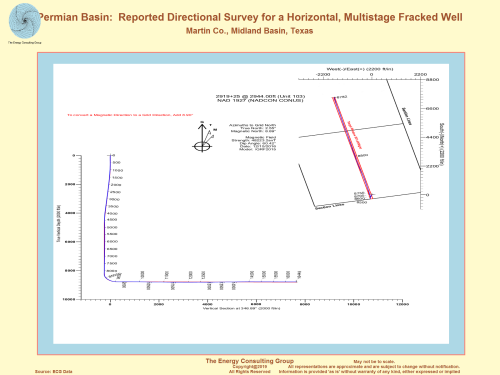
Click For Larger Image |
Permian Basin: Excerpt
From Frack Log For 50 Frack Stage Horizontal Well
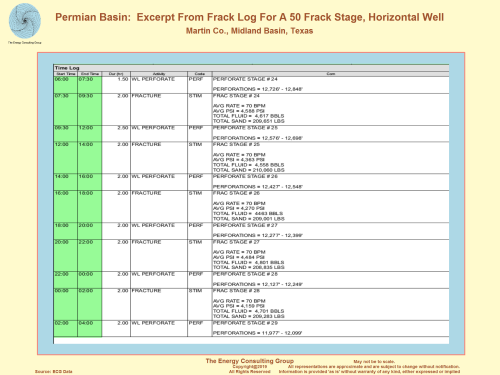
Click For Larger Image |
Energy Consulting Group data includes the
operational, and performance history for literally thousands of wells
across the Permian Basin. As illustrated by this example, this
data includes casing designs, well tests, directional surveys,
drilling/completion costs (AFE and actual), production performance, and
detailed frack data (number of stages, perforation depths, frac volumes,
pressures, etc.)
The
full frack log from which we pulled the summary
to the left is at this link. |
Permian Basin: Nonconventional Oil Footprint, Loving Co, TX
 |
|
Return to Web Page Index
Go to The Energy Consulting Group home page for more
oil and gas related information.






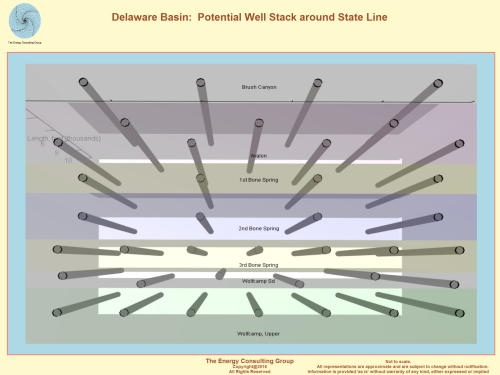
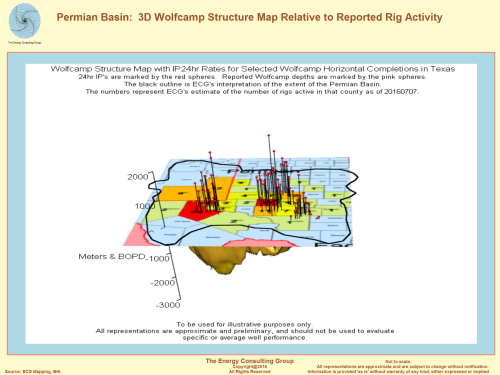
 To
the left is an example of our economic comparison map. The well level
economics reflect well performance (IP's, decline curves and EUR) as
communicated by individual companies for different plays, which we analyzed
using EVAL, our proprietary economic analysis program. We have over 500 such
assessements for the Permian oil nonconventionals, starting in 2010, which provides detailed insights on not only the
economic performance of the nonconventional plays in the Permian Basin, but
also allow us to investigate questions regarding rig and well productivity
growth, impact of changes in technology, how much oil the basin is likely to
produce at different oil prices, and which firms are best positioned to exploint
the nonconventionals. And, yes, we do realize that many of the answers in
the map have been removed. If interested in the map with all the blanks
filled in please contact us at insight@energy-cg.com.
To
the left is an example of our economic comparison map. The well level
economics reflect well performance (IP's, decline curves and EUR) as
communicated by individual companies for different plays, which we analyzed
using EVAL, our proprietary economic analysis program. We have over 500 such
assessements for the Permian oil nonconventionals, starting in 2010, which provides detailed insights on not only the
economic performance of the nonconventional plays in the Permian Basin, but
also allow us to investigate questions regarding rig and well productivity
growth, impact of changes in technology, how much oil the basin is likely to
produce at different oil prices, and which firms are best positioned to exploint
the nonconventionals. And, yes, we do realize that many of the answers in
the map have been removed. If interested in the map with all the blanks
filled in please contact us at insight@energy-cg.com.







